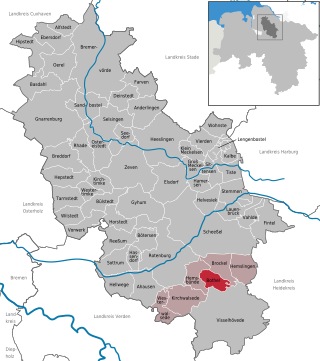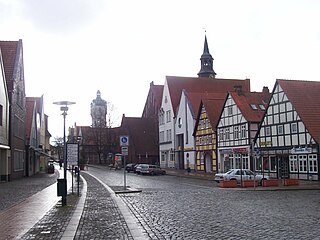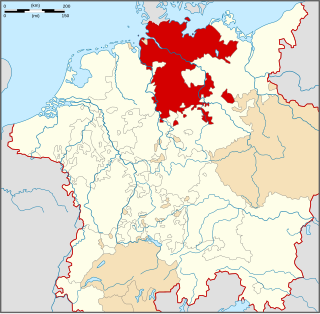
Rotenburg an der Wümme is a town in Lower Saxony, Germany. It is the capital of the district of Rotenburg.

Bothel is a municipality in the district of Rotenburg, Germany in the Stade Geest region of central Lower Saxony. It has 2,500 inhabitants. Bothel was founded by workers of the nearby Trochel Forest. The name developed from Borstel which is Old Saxon and means "little woods".

Verden an der Aller (German:[ˈfeːɐ̯dn̩ʔandɐˈʔalɐ] ; Northern Low Saxon: Veern), also called Verden (Aller) or simply Verden, is a town in Lower Saxony, Germany, on the river Aller. It is the district town of the district of Verden in Lower Saxony and an independent municipality (de:Selbständige Gemeinde). The town is located in the middle Weser region on the Aller river immediately before it flows into the Weser. As a center of horse breeding and equestrian sports, it bears the nickname "equestrian town". The suffix "Aller" was introduced at a time when the name "Verden" was also common for the French town of Verdun in the German-speaking area. The town name comes from "ford" or "ferry". The town was conveniently located at a ford through the Aller river, near an important trade route.

The Prince-Archbishopric of Bremen — not to be confused with the modern Archdiocese of Hamburg, founded in 1994 — was an ecclesiastical principality (787–1566/1648) of the Holy Roman Empire and the Catholic Church that after its definitive secularization in 1648 became the hereditary Duchy of Bremen. The prince-archbishopric, which was under the secular rule of the archbishop, consisted of about a third of the diocesan territory. The city of Bremen was de facto and de jure not part of the prince-archbishopric. Most of the prince-archbishopric lay rather in the area to the north of the city of Bremen, between the Weser and Elbe rivers. Even more confusingly, parts of the prince-archbishopric belonged in religious respect to the neighbouring Diocese of Verden, making up 10% of its diocesan territory.

The Archbishopric of Magdeburg was a Latin Catholic archdiocese (969–1552) and Prince-Archbishopric (1180–1680) of the Holy Roman Empire centered on the city of Magdeburg on the Elbe River.

Bremen-Verden, formally the Duchies of Bremen and Verden, were two territories and immediate fiefs of the Holy Roman Empire, which emerged and gained imperial immediacy in 1180. By their original constitution they were prince-bishoprics of the Archdiocese of Bremen and Bishopric of Verden.
Münster is a city in North Rhine-Westphalia, Germany, where the Peace of Westphalia was signed.
Oldenburg may also refer to:
A Diocesan Administrator is a provisional ordinary of a Catholic particular church.

The Lower Saxon Circle was an Imperial Circle of the Holy Roman Empire. It covered much of the territory of the medieval Duchy of Saxony, and was originally called the Saxon Circle before later being better differentiated from the Upper Saxon Circle by the more specific name.

The Diocese of Halberstadt was a Roman Catholic diocese from 804 until 1648. From 1180, the bishops or administrators of Halberstadt ruled a state within the Holy Roman Empire, the prince-bishopric of Halberstadt. The diocesan seat and secular capital was Halberstadt in present-day Saxony-Anhalt.

The Prince-Bishopric of Münster was a large ecclesiastical principality in the Holy Roman Empire, located in the northern part of today's North Rhine-Westphalia and western Lower Saxony. From the sixteenth to the eighteenth centuries, it was often held in personal union with one or more of the nearby ecclesiastical principalities of Cologne, Paderborn, Osnabrück, Hildesheim, and Liège.

The Prince-Bishopric of Minden was an ecclesiastical principality of the Holy Roman Empire. It was progressively secularized following the Protestant Reformation when it came under the rule of Protestant rulers, and by the Peace of Westphalia of 1648 given to Brandenburg as the Principality of Minden. It must not be confused with the Roman Catholic diocese of Minden, which was larger, and over which the prince-bishop exercised spiritual authority.

Hemsbünde is a municipality in the district of Rotenburg, in Lower Saxony, Germany.

Lauenbrück is a municipality in the district of Rotenburg, in Lower Saxony, Germany.

The Prince-Bishopric of Ratzeburg was an ecclesiastical principality of the Holy Roman Empire that was located in what is today the states of Schleswig-Holstein and Mecklenburg-Vorpommern in Germany. It was established in 1236 and disestablished following the Peace of Westphalia in 1648. The state capital was the city of Ratzeburg. The Diocese of Ratzeburg had originally been established as a diocese of the Catholic Church in the 11th century but had fallen into abeyance; as a result of the Wendish Crusade, the diocese was re-created in the middle of the 12th century. The territory of the prince-bishopric was managed by secular lords on behalf of the Bishop of Ratzeburg. As a Prince-Bishopric of the Empire, the territory of the state was not identical with that of the bishopric, but was located within its boundaries and made up about a quarter of the diocesan area. When the Prince-Bishopric was disestablished, a new entity was established — the Principality of Ratzeburg. The principality became an exclave of the Duchy of Mecklenburg-Strelitz.

The Prince-Bishopric of Lübeck, was an ecclesiastical principality of the Holy Roman Empire until 1803. Originally ruled by Roman-Catholic bishops, after 1586 it was ruled by lay administrators and bishops who were members of the Protestant Holstein-Gottorp line of the House of Oldenburg. The prince-bishops had seat and vote on the Ecclesiastical Bench of the College of Ruling Princes of the Imperial Diet.

In the Holy Roman Empire, the German term Hochstift referred to the territory ruled by a bishop as a prince, as opposed to his diocese, generally much larger and over which he exercised only spiritual authority. The terms prince-bishopric and ecclesiastical principality are synonymous with Hochstift. Erzstift and Kurerzstift referred respectively to the territory (prince-archbishopric) ruled by a prince-archbishop and an elector-archbishop while Stift referred to the territory ruled by an imperial abbot or abbess, or a princely abbot or abbess. Stift was also often used to refer to any type of ecclesiastical principality.

The Prince-Bishopric of Verden was an ecclesiastical principality of the Holy Roman Empire that was located in what is today the state of Lower Saxony in Germany. Verden had been a diocese of the Catholic Church since the middle of the 8th century. The state was disestablished in 1648. The territory was managed by secular lords on behalf of the Bishop of Verden. As a Prince-Bishopric of the Empire, the territory of the state was not identical with that of the bishopric, but was located within its boundaries and made up about a quarter of the diocesan area. By the terms of the Peace of Westphalia, the Prince-Bishopric was disestablished and a new entity was established, the Duchies of Bremen and Verden.

The Diocese of Verden was a diocese of the Catholic Church. It was founded around AD 768 as a suffragan of the Archdiocese of Mainz. It was suppressed in 1648 as part of the Peace of Westphalia. The diocese was centered on the city of Verden an der Aller in what is today the state of Lower Saxony, Germany. The cathedral church of the diocese was dedicated to Ss Mary and Cecilia in 1028 but the building was only completed in 1490. The Bishop of Verden was also, ex officio, the ruler of a principality of the Holy Roman Empire — the Prince-Bishopric of Verden. The territory of the diocese was not identical with that of the prince-bishopric; while the state was located within the boundaries of the diocese, it amounted to less than a quarter of the diocesan territory. Its last bishop was Franz Wilhelm, Count von Wartenberg. Following the Thirty Years' War, Verden, along with the neighbouring sees of Minden and Bremen, fell into the hands of Protestants. Wartenberg was only able to retain the See of Osnabrück.















